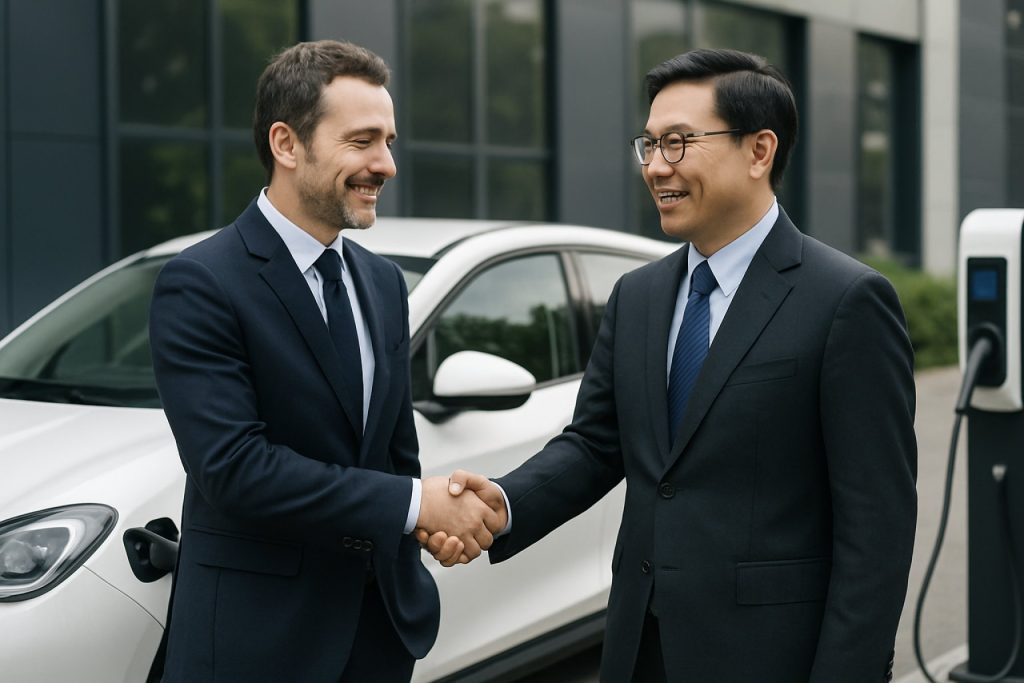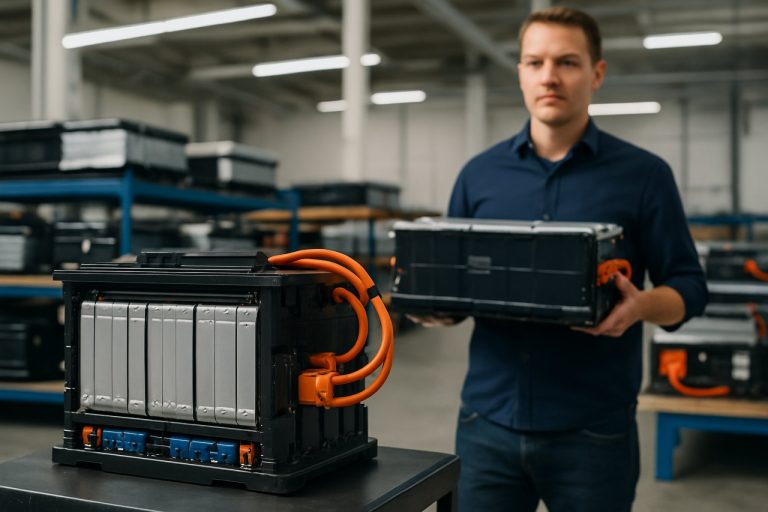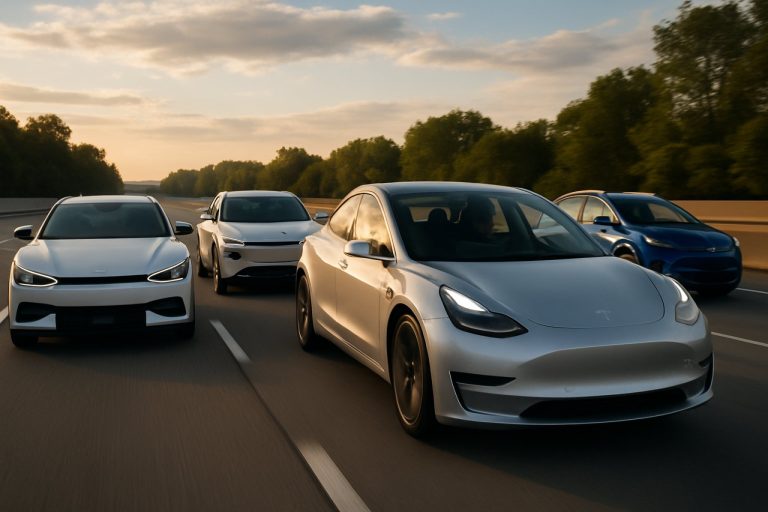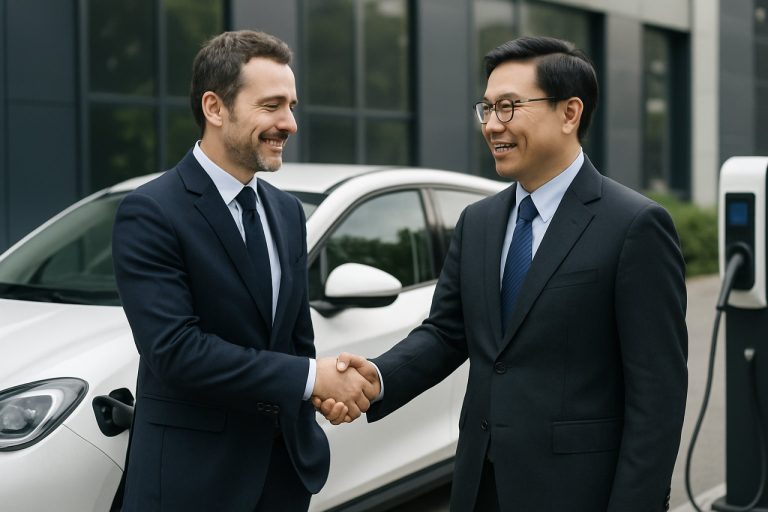
- Foxconn, Taiwan’s tech powerhouse known for assembling iPhones, is rapidly transforming the electric vehicle (EV) industry with its Foxtron subsidiary.
- By partnering with veteran Yulon Motor, Foxconn blends electronics expertise with automotive manufacturing, leveraging its open-source MIH platform for EV development.
- The company focuses on supplying modular EV technology to global automakers, enabling brands like Mitsubishi to quickly launch their own electric vehicles.
- This new model democratizes car manufacturing, reducing development costs and timelines—cars can now be designed like smartphones, accelerating innovation.
- Foxconn’s rise signals a broader shift: the future of automotive success lies in advanced electronics, flexible platforms, and strategic tech-industry partnerships.
Crowds at auto shows love the adrenaline of a sleek new car. Yet, few paused to realize that behind some of the world’s most intriguing electric vehicles, a silent revolution is gaining speed—not from Detroit, not from Tokyo, but from the humming tech corridors of Taiwan.
Taiwan’s Electronics Giant Steps Onto the Global Stage
Known for orchestrating the orchestration—the complex, masterful assembly—of Apple’s iPhones, Foxconn (formally Hon Hai Precision Industry) built its empire not on cars but on chips and circuit boards. For decades, it was the unseen force behind gadgets that define how we live. Now, Foxconn engineers are busy in clean rooms and soundless test facilities, crafting vehicles with the same finesse once reserved for the world’s favorite smartphones.
A Daring Leap: From Phones to Electric Cars
After conquering the electronics supply chain, Foxconn unleashed its ambitions in 2020, unveiling its first EV-dedicated subsidiary, Foxtron. The debut was breathless: a sedan christened “Model E” in 2021, an electric bus “Model T,” and then a dizzying stream of prototypes—including the head-turning crossover “Model B” in 2022. No other electronics company has orchestrated such a fleet so swiftly.
But Foxconn, despite its scale, didn’t go it alone. It found a natural partner in Yulon Motor, a Taiwanese automobile veteran that spent years perfecting internal combustion vehicles under license for names like Nissan. Together, they forged Foxtron—Foxconn commanding a 51% share, Yulon 49%.
Not Your Average Carmaker
Foxconn’s vision for the car industry breaks every mold. It doesn’t yearn to emblazon its own name on tailgates or pander to consumer nostalgia. With its open-source EV platform MIH (Mobility in Harmony), Foxconn is building the backbone, the technology, and the wheels—leaving customers, including legacy automakers, to add their emblem. This isn’t just badge engineering; it’s the democratization of car manufacturing, a platform as flexible as the smartphones Foxconn assembles.
Commercial vehicles? Sold with the Foxtron name. Mainstream passenger cars? Designed to be rebadged and enter the market under a partner’s marquee.
The Mitsubishi Connection: A Shift in the Global Order
Many were caught off guard this spring when Mitsubishi Motors, a stalwart of Japan’s auto industry, inked a broad technical memorandum with Foxconn. The particulars? Electric vehicles birthed by Foxconn’s MIH platform and manufactured with scientific precision, shipped under Mitsubishi’s banner to consumers in Australia and New Zealand. It’s a reversal of power: the old guard seeking agility from the digital giants of Taiwan.
Key Takeaway: The Future of Cars, Built Like Phones
This fast-moving convergence between electronics and autos portends a dramatic shift. Foxconn’s manufacturing wizardry and open engineering could slash development costs and timelines for electric vehicles, redefining how—and by whom—cars are made. It’s not beneath the hood but beneath the structure where transformation is unfolding.
The automotive industry once demanded dynastic capital, sprawling factories, and time-consuming development. Foxconn’s schema could mean the next big name in cars is simply whoever thinks up the winning concept—and Foxconn will be ready to build it.
One more reality worth remembering: as the EV market accelerates, so too does the blending of industries. Where a badge used to denote legacy and trust, the substance may soon lie in the circuitry and code behind it—and the crafter just might be wearing lab coats, not coveralls. The world’s carmakers are watching, and so are you.
Taiwan’s EV Game Changer: Why Foxconn’s “iPhone-style” Cars Will Upend the Auto Industry!
The Silent Surge: Foxconn’s Drive Into Electric Vehicles
While crowds cheer futuristic EVs at auto shows, few recognize the power shift taking place far from America’s Motor City or Japan’s industrial heartland. Behind the scenes, Taiwan’s tech titan Foxconn is stealthily pioneering the next wave of cars—built with the precision, scalability, and speed that revolutionized smartphones. Here’s what you need to know about this “iPhone moment” for the automotive world, why it matters, and what to expect next.
—
Deeper Dive: Foxconn’s EV Master Plan
1. Foxconn’s MIH Platform—The “Android” of Electric Vehicles
– Open-Source Approach: Foxconn’s MIH platform is akin to Android in mobile—allowing automakers and startups to build their own electric vehicles from a common, customizable base. This is in sharp contrast to Tesla’s highly proprietary systems.
– Global Adoption: Over 2,300 companies and partners, from battery suppliers to software firms, have joined the MIH EV Open Platform Alliance as of early 2024 [[Reuters](https://www.reuters.com)].
– Compatibility & Modularity: The platform supports a range of vehicle types, from sedans to SUVs and buses, slashing R&D cycles from years to potentially mere months.
2. Manufacturing Muscle—Scaling Like Smartphones
– Foxconn’s Supply Chain Prowess: Foxconn manages an estimated 40–50% of the world’s electronic supply chain, according to [Bloomberg](https://www.bloomberg.com). This gives it a unique edge in procurement, quality control, and rapid iteration for vehicles.
– Automotive Factories: New facilities in Thailand, USA (Ohio), and Mexico are being readied to assemble EVs. This global footprint is designed to cut logistics costs and adapt to regional regulations.
3. Feature Set—What Makes Foxconn’s EVs Unique?
| Feature | Description |
|—————–|—————————————————–|
| Flex Architecture| Variable wheelbase, battery size, and drive layouts|
| OTA Updates | Over-the-air software updates, just like smartphones|
| AI/IoT Ready | Embedded support for smart driving and connectivity |
| Safety | Built-in advanced driver assistance (ADAS) |
| Customization | White-labeling for partner automakers’ branding |
4. Security, Sustainability & Compliance
– Security: Foxconn leverages years of experience in mobile cybersecurity, applying robust encryption for EV software and telematics.
– Sustainability: Focus on recyclable materials, battery recycling partnerships, and renewable-powered factories (source: [Foxconn ESG Report](https://www.foxconn.com)). Life cycle emissions are a key focus.
– Compliance: Already certified or in process for major global standards, including ISO 26262 (road vehicle functional safety).
—
Market Trends & What’s Next
– Global EV Market Surge: EVs are set to comprise over 30% of new cars sold worldwide by 2030 (IEA forecast), with flexible platforms needed to meet demand.
– “B2B” Revolution: Most EV headlines go to flashy brands, but analysts agree the huge profit opportunity is in B2B platform licensing and manufacturing for third parties—exactly Foxconn’s sweet spot.
– Competitors: Companies like Magna, Bosch, and platform players like Rivian are racing to offer similar contract-building services, but Foxconn’s unmatched electronics scale gives it a head start.
—
Top Reader Questions—Answered
How Does Foxconn’s MIH Platform Compare with Tesla?
– Customizability: MIH is open to any automaker, not just for Foxconn’s captive use.
– Speed: Foxconn’s approach can help brands launch vehicles up to 40% faster than traditional methods.
– Cost: Licensing MIH can reduce up-front engineering expenses and provide economies of scale, letting startups “skip” billion-dollar investments.
Who Can Build a Car with Foxconn?
– Ev start-ups with big ideas but limited manufacturing prowess.
– Established automakers (like Mitsubishi) seeking fast, low-cost electrification.
– Non-car companies (Sony, for instance) exploring mobility.
Are Foxconn EVs Available Now?
– Foxtron Model T electric bus is in limited commercial use in Taiwan.
– Passenger car availability will ramp up through partnerships—expect to see Mitsubishi-branded Foxconn EVs in Australia/New Zealand by 2025.
What are the Risks or Limitations?
– Execution: Transitioning from electronics to automotive is not trivial—vehicle durability and safety are paramount.
– Brand Control: Legacy automakers may worry about “losing their soul” if outsourcing too much technology.
– Competition: Other contract manufacturers are catching up, particularly in China.
—
Quick How-To: Launching an EV Brand Using Foxconn’s MIH
1. Join the MIH Alliance: Startups or brands can apply for access to the platform, collaborate on design, and test prototypes.
2. Customize Specs: Choose battery range, powertrain, and feature sets that fit your market.
3. Co-Develop Software: Build unique experiences using MIH’s open API and IoT modules.
4. Brand and Market: White-label your vehicle, focus on branding and sales, while Foxconn handles manufacturing and compliance.
—
Actionable Life Hacks for the EV Curious
– For Entrepreneurs: You no longer need billion-dollar factories—Foxconn’s “EV as a Service” model democratizes car-making.
– For Consumers: Pay attention to badge engineering. The next big EV might not come from a traditional carmaker, but could feature innovative tech from behind-the-scenes firms like Foxconn.
– For Investors: Stay alert to Taiwan’s growing role in global auto supply chains. Contract manufacturing may be the most underestimated trend in the EV boom.
—
Controversies & Challenges
– Labor and Human Rights: Foxconn has faced global scrutiny over working conditions in its electronics plants; observers are watching closely as it expands into automotive.
– Reliance on Partners: Success hinges on attracting enough partners to sustain economies of scale.
– Brand Dilution Risk: With many cars sharing the same guts, brands must innovate to stand out beyond mere logos.
—
Final Recommendations
– Entrepreneurs & Startups: Join alliances like MIH early to leverage shared knowledge and speed to market.
– Automakers: Consider Foxconn’s model as a fast track for electrification, especially for niche or emerging markets.
– Consumers: Seek transparency—ask what’s under the hood, and don’t judge a new EV only by its badge.
—
Discover more about Foxconn’s journey and platform vision at their official Foxconn site, and stay updated on global EV trends at Yulon Motor.
—
Keywords: Foxconn electric vehicles, MIH platform, contract EV manufacturing, Foxtron, electric vehicle trends, OEM, automotive platform, battery tech, EV open source, Foxconn Mitsubishi partnership
Ready for the next automotive revolution? Keep your eyes on Taiwan’s tech wizards—your next ride might just be “made like an iPhone.”



